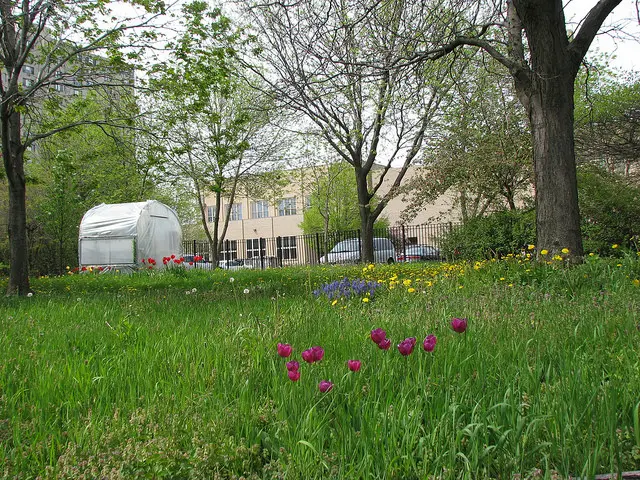By Gabriel Piemonte
I’m in an open field just past twilight, carrying a shovel and a bucket I just pulled from my trunk. It’s late December, so the remaining light is quickly diminishing. I’m in an overcoat and a trilby hat. I pull out a pair of gloves from the bucket and put them on. Then I begin to dig.
It wouldn’t surprise me if somebody looking out his or her window found the scene suspicious. The field sits in the center of a city block. It was abandoned by its owner for years before the city eventually took possession of it. For a long time, if anybody was doing anything there, it was probably a little suspicious.
Many might ask, “What is any decent person doing hanging around a vacant city lot?â€
Many people reading this probably have an excellent answer to that question. We plant seeds there. We grow there. We celebrate life there.
But not usually at night. Not usually in overcoats. And not usually in winter.
Although I started in a field three-quarters-of-a-mile from the local high school, this story is about Hyde Park Academy – which, despite its name, is in the Woodlawn community and serves the residents of Woodlawn as a neighborhood school. Hyde Park Academy is part of a growing renaissance in Woodlawn in more ways than one.
My moonlight mission is a baby step towards a new urban agriculture project. Last summer, I began an Urban Agriculture Basics course at Hyde Park Academy, with 13 students and two brilliant instructors. I’ve ended up digging in the dirt in December to ensure that we have a more successful program come thaw.

Growing space at Hyde Park Academy in the spring
At the school, we’re rehabilitating a sprawling space that was donated to the school and turned into a green oasis in the ’90s. Unfortunately, it’s been largely neglected since then, but the school’s new principal is eager to see it put to productive use with the help of students.
The space is incredible, but an important piece of the puzzle for our budding growers to learn is how spaces that are considered an eyesore – like a vacant lot in the middle of a block – can be turned into an asset. This coming season, I am determined that we will have a vacant lot to apply the lessons of the class as we go through the process of transformation. To ensure we’re doing right by the community, I’m testing the soil as early as possible for contaminants, so we know whether we have to grow entirely out of compost and whether remediation should be part of our plan.
I’ve been surprised in the past just how much of the land in Woodlawn is in good shape. Nature has healed what people have made a mess of. The problem with a lot of this land is not the quality of the soil but the quantity; there is way more rubble than earth, a byproduct of the fast-track demolition that tore apart the neighborhood for decades.
In recent years, garden projects have become all the rage in the neighborhood. Small plantings line the Metra tracks for about a block in one area. Another stretch of a street in the community boasts three gardens that collectively take up half a city block.
That’s not to say that growing and beautification are new to Woodlawn. Some of this activity has been going on for many years. Small beautification projects are always popping up across the neighborhood. There’s a woman who has attained near-legendary status in the community for her cleanup efforts. She can be seen at all hours of the day and all over Woodlawn – often dressed as if she’s on her way to some fancy event. It seems that, for her, cleaning up her community is a fancy event.
She’s just one of a many-faceted cast of characters that are all working hard in their quirky ways to remake a community that has developed a reputation that has to be overcome before most people can see Woodlawn for what it truly is. In Chicago, the toxic combination of racial prejudice and stubborn associations connected to certain areas conspire to drown out good news with louder shouts about any instance of crime or tragedy.
Not surprisingly, Hyde Park Academy struggles with the same prejudices. But the school is a hidden gem, and the students I have been fortunate enough to work with have impressed me with their intelligence, their generosity of spirit, and their strong work ethic. They are exceptional and under-appreciated.
This is what sends me to this lot just after work, digging frantically in my work clothes while there is still a little light and the ground is still soft enough to dig in. I’ll send the soil off to be tested in the next couple of weeks, and as the ground hardens, I will be dreaming the dreams of growers all over the world in the winter, dreams of tomatoes and peppers and onions and strawberries – with a brand new space to design and grow in.

–
AUA welcomes blog contributions from Chicago’s diverse urban agriculture community, including AUA members and non-members alike. Since AUA is a coalition of individuals, organizations and businesses that strives to represent the broad interests of it constituency in a democratic and transparent manner, it is important to note that the views expressed on the AUA Blog do not necessarily represent those officially endorsed by AUA.Â